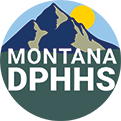FOR IMMEDIATE RELEASE
Date: May 08 2025
Contact: Jon Ebelt, Communications Director, DPHHS, (406) 444-0936, (406) 461-3757
jebelt@mt.gov
Resources Available to Help Combat Asthma in Montana
May is National Asthma and Allergy Awareness Month
State health officials are raising awareness about resources available in Montana to combat the health consequences and personal and financial costs associated with asthma during National Asthma and Allergy Awareness Month in May.
“Barriers such as high costs, limited insurance coverage, and rural pharmacy access can make it difficult for many to get the medications they need,” said BJ Biskupiak, Program Manager for the Department of Public Health and Human Services (DPHHS) Montana Asthma Control Program (MACP). “Ensuring that every community has access to these life-saving treatments is key to helping people stay healthy, avoid emergency care, and live full, active lives.”
Biskupiak said common symptoms of asthma include coughing, wheezing, shortness of breath, and chest tightness. While asthma can be controlled, asthma attacks can cause adults to miss work and children to miss school. These dangerous and sometimes life-threatening episodes reduce the quality of life for people with asthma.
Inhaled medications are essential for managing asthma, but many Montanans struggle to afford or access them regularly. Nearly a quarter (22.5%) of Montana adults with current asthma only have a controller medication, while 28.5% of adults only have rescue medication. More than one in ten (11.5%) adults have both rescue and controller medication, while over a third (37.5%) have neither. Fourteen percent of Montana adults with asthma report they are not able to fill their asthma medications due to cost.
The MACP is partnering with local health departments, schools, clinics, and pharmacies to improve access to medications and support through a variety of strategies. Some of the key strategies include implementing the Montana Asthma Home Visiting Program (MAP), highlighting pharmacy assistance programs, supporting school-based asthma education programs, and guiding clinical quality improvement projects.
The MAP is a free education program available to Montana residents of any age who are living with uncontrolled asthma. The MAP involves six points of contact over a 12-month period with a health care professional trained in asthma education and environmental trigger control. Clients receive tailored asthma education, a home environmental assessment, linkage to social support, a spacer for medication delivery, and a high efficiency particulate air (HEPA) purifier.
An important piece of the provided asthma education includes review of inhaler technique and discussion about what medication may be right for each individual.
Results from visits with over 900 Montanans show that MAP participants report missing fewer days of school and work due to asthma while participating in the program and visit the emergency department less frequently than before entering the program.
All participants experience fewer days with symptoms and nearly all participants have good inhaler technique and an asthma action plan upon completing the program. More information on the MAP and other MACP activities can be found at asthma.mt.gov.
To learn more about asthma control and management, visit asthma.mt.gov. Additional resources from the Centers for Disease Control and Prevention can be found at www.cdc.gov/asthma.
To learn how to raise awareness about asthma, visit the Global Initiative for Asthma (GINA) at www.ginasthma.org. For support with health insurance coverage, visit www.covermt.org.
For air quality information, visit the Montana Department of Environmental Quality’s websites, https://deq.mt.gov/air/ and http://todaysair.mtdeq.us/. A national fire and smoke map is also available from the U.S. Interagency Wildland Fire Air Quality Response Program and the U.S. Environmental Protection Agency (EPA), https://fire.airnow.gov/.

